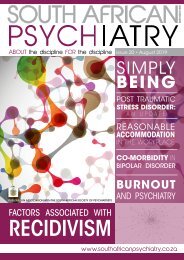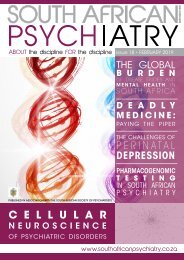South African Psychiatry - November 2018
South African Psychiatry - November 2018
South African Psychiatry - November 2018
You also want an ePaper? Increase the reach of your titles
YUMPU automatically turns print PDFs into web optimized ePapers that Google loves.
SASOP HEADLINE<br />
o<br />
Global mental health where APA can and<br />
should lead the way for colleagues around<br />
the world in innovative treatment programs<br />
o Exploring social determinants of mental<br />
health, including racism, sexism, ageism and<br />
homophobia, that continue to affect the mental<br />
health and psychological well-being of many<br />
Americans, and how organized psychiatry can<br />
and should respond to these issues<br />
“I am looking forward to working with our internal<br />
and external stakeholders over the next 12 months<br />
to advance the goals of our organization and the<br />
profession of psychiatry around the globe,” Stewart<br />
said. “The APA will be active in speaking out about<br />
the challenges facing the nation and how they<br />
affect mental health. I want to thank my colleagues<br />
for putting their trust in me to lead this organization.”<br />
https://academic.uthsc.edu/faculty/facepage.<br />
php?netID=astewa59&personnel_id=339785<br />
ADDENDUM 2. WATCH OUT FOR WARNING<br />
SIGNS OF TEEN SUICIDE<br />
Statistics on teen suicide tell an alarming tale of lost<br />
potential among our country’s youth – a loss that in<br />
many cases is preventable if more parents, teachers,<br />
community leaders and mental health professionals<br />
are alert to the warning signals of mental distress.<br />
ALMOST ONE IN TEN TEENAGE DEATHS<br />
IN SOUTH AFRICA EVERY YEAR ARE THE<br />
RESULT OF SUICIDE, ACCORDING TO THE<br />
SA DEPRESSION AND ANXIETY GROUP<br />
(SADAG), AND UP TO 20 % OF HIGH<br />
SCHOOL LEARNERS HAVE TRIED TO TAKE<br />
THEIR OWN LIVES.<br />
The 2011 Youth Risk Behaviour Survey (YRBS) found<br />
that a quarter of grade 8-11 learners across all<br />
<strong>South</strong> Africa’s provinces had felt so sad or hopeless<br />
that they couldn’t engage in their usual daily<br />
activities for two weeks or more. More than one in<br />
six had either thought about suicide, made plans to<br />
commit suicide, or attempted it at least once in the<br />
past six months.<br />
The phenomenon is not unique to <strong>South</strong> Africa. The<br />
World Health Organisation (WHO) ranks depression<br />
as the third highest disease burden amongst<br />
adolescents globally, and suicide the second<br />
leading cause of death in 15- to 29-year-olds.<br />
THIS SUGGESTS A LARGE PROPORTION<br />
OF TEENAGERS ARE SUFFERING FROM<br />
UNDETECTED OR UNTREATED MENTAL<br />
AND EMOTIONAL HEALTH PROBLEMS<br />
WHICH CAN SERIOUSLY IMPACT ON THEIR<br />
FUTURE POTENTIAL. THE YOUTH ARE THE<br />
FUTURE OF OUR COUNTRY AND WE NEED<br />
TO ACT TO PREVENT THE DEVASTATING<br />
CONSEQUENCES OF THEM LOSING<br />
THEIR HOPE FOR THE FUTURE.<br />
Depression and other mental health disorders<br />
have a serious impact on the individual’s ability to<br />
function and perform their normal activities while<br />
the WHO notes growing evidence that promoting<br />
and protecting adolescent health brings long-term<br />
benefits to economies and society. Healthy young<br />
adults are able to make greater contributions to<br />
the workforce, their families and communities, and<br />
society as a whole.<br />
“Young people and mental health in a changing<br />
world” was the theme for World Mental Health Day<br />
on 10 October this year, acknowledging the impact<br />
on young people of multiple social and physical<br />
changes as they move through their teens towards<br />
adulthood, and the need to build mental resilience<br />
from an early age to ensure young people are<br />
equipped to cope with the challenges of today’s<br />
world.<br />
THE CAUSES OF DEPRESSION AND<br />
RELATED MENTAL ILLNESSES IN<br />
TEENAGERS AND YOUNG ADULTS ARE<br />
MULTI-FACETED. THERE IS THE STRESSFUL<br />
NATURE OF THE TEENAGE YEARS –<br />
FOR SOME TEENAGERS, THE NORMAL<br />
DEVELOPMENTAL CHANGES OF THESE<br />
YEARS, SUCH AS BODILY CHANGES,<br />
NEW PATTERNS OF THOUGHTS AND<br />
FEELINGS, CAN BE UNSETTLING AND<br />
OVERWHELMING.<br />
There are social changes too, like changing schools,<br />
the pressure of final exams, the prospect of leaving<br />
home to start tertiary studies or a job; as well as other<br />
stress factors such as family issues and changes in<br />
friendship networks, while the new world of alwayson<br />
technology and social media brings additional<br />
pressures.<br />
Problems appear too big, too difficult or embarrassing<br />
to overcome, and suicide may look like the only<br />
option.<br />
What then is to be done?<br />
Prevention of teen suicides starts with better<br />
understanding of the symptoms of depression.<br />
Suicides rarely happen without warning, and<br />
98 * SOUTH AFRICAN PSYCHIATRY ISSUE 17 <strong>2018</strong>

















